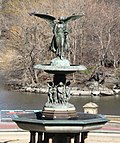
Central Park is an urban park in New York City located between the Upper West and Upper East Sides of Manhattan. It is the fifth-largest park in the city by area, covering 843 acres (3.41 km2). It is the most visited urban park in the United States with an estimated 38 million visitors annually, and is the most filmed location in the world.

Duck is the common name for numerous species in the waterfowl family Anatidae which also includes swans and geese. Ducks are divided among several subfamilies in the family Anatidae; they do not represent a monophyletic group but a form taxon, since swans and geese are not considered ducks. Ducks are mostly aquatic birds, mostly smaller than the swans and geese, and may be found in both fresh water and sea water.

The mallard is a dabbling duck that breeds throughout the temperate and subtropical Americas, Eurosiberia, and North Africa and has been introduced to New Zealand, Australia, Peru, Brazil, Uruguay, Argentina, Chile, Colombia, the Falkland Islands, and South Africa. This duck belongs to the subfamily Anatinae of the waterfowl family Anatidae. The male birds (drakes) have a glossy green head and are grey on their wings and belly, while the females have mainly brown-speckled plumage. Both sexes have an area of white-bordered black or iridescent blue feathers called a speculum on their wings; males especially tend to have blue speculum feathers. The mallard is 50–65 cm (20–26 in) long, of which the body makes up around two-thirds the length. The wingspan is 81–98 cm (32–39 in) and the bill is 4.4 to 6.1 cm long. It is often slightly heavier than most other dabbling ducks, weighing 0.72–1.58 kg (1.6–3.5 lb). Mallards live in wetlands, eat water plants and small animals, and are social animals preferring to congregate in groups or flocks of varying sizes. This species is the main ancestor of most breeds of domesticated ducks.

The ring-necked duck is a diving duck from North America commonly found in freshwater ponds and lakes. The scientific name is derived from Greek aithuia an unidentified seabird mentioned by authors including Hesychius and Aristotle, and Latin collaris, "of the neck" from collum, "neck".

The American black duck is a large dabbling duck in the family Anatidae. It was described by William Brewster in 1902. It is the heaviest species in the genus Anas, weighing 720–1,640 g (1.59–3.62 lb) on average and measuring 54–59 cm (21–23 in) in length with a 88–95 cm (35–37 in) wingspan. It somewhat resembles the female mallard in coloration, but has a darker plumage. The male and female are generally similar in appearance, but the male's bill is yellow while the female's is dull green with dark marks on the upper mandible. It is native to eastern North America. During the breeding season, it is usually found in coastal and freshwater wetlands from Saskatchewan to the Atlantic in Canada and the Great Lakes and the Adirondacks in the United States. It is a partially migratory species, mostly wintering in the east-central United States, especially in coastal areas.

The wood duck or Carolina duck is a species of perching duck found in North America. It is one of the most colorful North American waterfowl.

The mandarin duck is a perching duck species native to the East Palearctic. It is medium-sized, at 41–49 cm (16–19 in) long with a 65–75 cm (26–30 in) wingspan. It is closely related to the North American wood duck, the only other member of the genus Aix. Aix is an Ancient Greek word which was used by Aristotle to refer to an unknown diving bird, and galericulata is the Latin for a wig, derived from galerum, a cap or bonnet.

The ruddy duck is a duck from North America and one of the stiff-tailed ducks. The genus name is derived from Ancient Greek oxus, "sharp", and oura, "tail", and jamaicensis is "from Jamaica".

Aix is a bird genus that contains two species of ducks: the wood duck, and the Mandarin duck. Aix is an Ancient Greek word used by Aristotle to refer to an unknown diving bird.

The falcated duck or falcated teal is a gadwall-sized dabbling duck from the east Palearctic

The Australian wood duck, maned duck or maned goose is a dabbling duck found throughout much of Australia. It is the only living species in the genus Chenonetta. Traditionally placed in the subfamily Anatinae, it might belong to the subfamily Tadorninae (shelducks); the ringed teal may be its closest living relative.
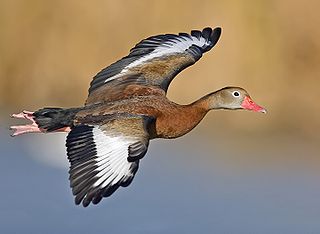
The black-bellied whistling duck, formerly called the black-bellied tree duck, is a whistling duck that breeds from the southernmost United States and tropical Central to south-central South America. In the US, it can be found year-round in peninsular Florida, parts of southeast Texas, coastal Alabama and seasonally in southeast Arizona, and Louisiana's Gulf Coast. It is a rare breeder in such disparate locations as Arkansas, Georgia, Tennessee, and South Carolina, though it is now a common breeder in parts of central Florida. There is a large population of several hundred that winter each year in Audubon Park in uptown New Orleans, Louisiana. Since it is one of only two whistling duck species native to North America, it is occasionally just known as the "whistling duck" or "Mexican squealer" in the southern USA.

Belvedere Castle is a folly in Central Park in Manhattan, New York City. It contains exhibit rooms and an observation deck, and since 1919, has also housed the official Central Park weather station.

Zelda was a female wild turkey that lived at the Battery, a park in New York City, between mid-2003 and c. September 26, 2014. Although flocks of wild turkeys are more common in the city's greener parts due to the ban on hunting, Zelda was believed to be the only one in Manhattan. Previous Manhattan turkeys included Giuliani and Hedda Gobbler.
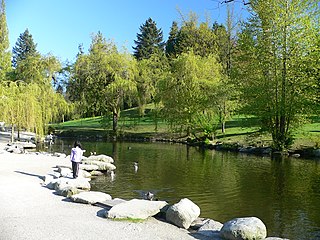
A duck pond is a pond for ducks and other waterfowl. Duck ponds provide habitats for water fowl and other birds, who use the water to bathe in and drink.
Gothamist LLC was the operator, or in some cases franchisor, of eight city-centric websites that focused on news, events, food, culture, and other local coverage. It was founded in 2003 by Jake Dobkin and Jen Chung. In March 2017, Joe Ricketts, owner of DNAinfo, acquired the company and, in November 2017, the websites were temporarily shut down after the newsroom staff voted to unionize. In February 2018, it was announced that WNYC, KPCC and WAMU had acquired Gothamist, LAist and DCist, respectively. Chicagoist was purchased by Chicago-born rapper Chance the Rapper in July 2018.
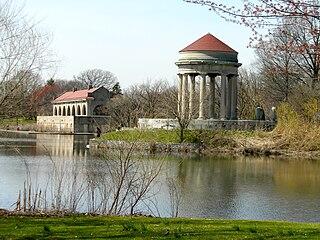
Franklin Delano Roosevelt (FDR) Park is an aesthetically designed park located along the Delaware River in the southernmost point of South Philadelphia, Pennsylvania, comprising some 348 acres (1.41 km2) which includes a 146-acre (0.59 km2) golf course, about 125 acres (0.51 km2) of buildings, roadways, pathways for walking, landscaped architecture, and a variety of picnic and recreation areas placed within about 77 acres (310,000 m2) of natural lands including ponds and lagoons.
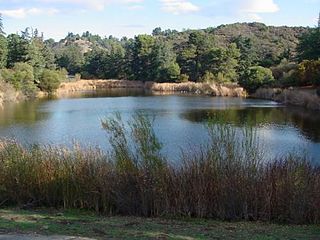
Franklin Canyon Park is a public park located near Benedict Canyon at the eastern end of the Santa Monica Mountains. The park comprises 605 acres (2.45 km2), and is located at the purported geographical center of the city of Los Angeles. The park features a 3-acre (12,000 m2) lake, a duck pond and over five miles (8 km) of hiking trails.

The Pond and Hallett Nature Sanctuary are two connected features at the southeastern corner of Central Park in Manhattan, New York City. It is located near Grand Army Plaza, across Central Park South from the Plaza Hotel, and slightly west of Fifth Avenue. The Pond is one of seven bodies of water in Central Park.
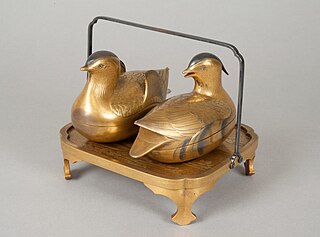
The Metropolitan Museum of Art has a pair of 17th-century Japanese lacquered wood incense boxes in the shape of mandarin ducks in its collection.
























